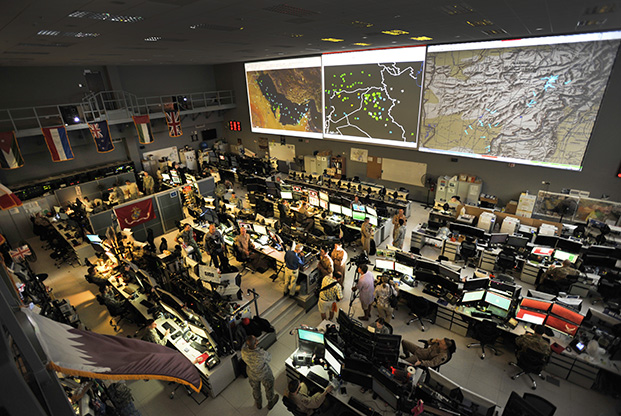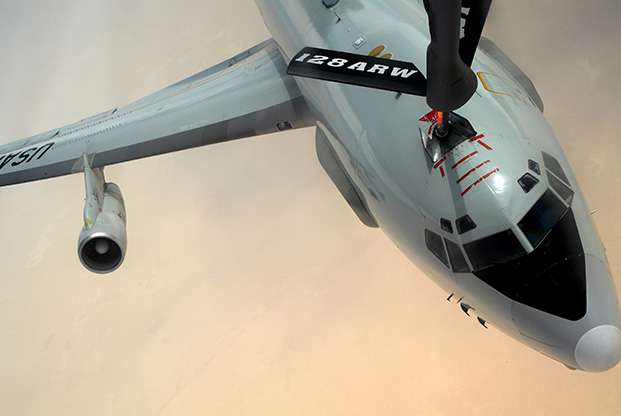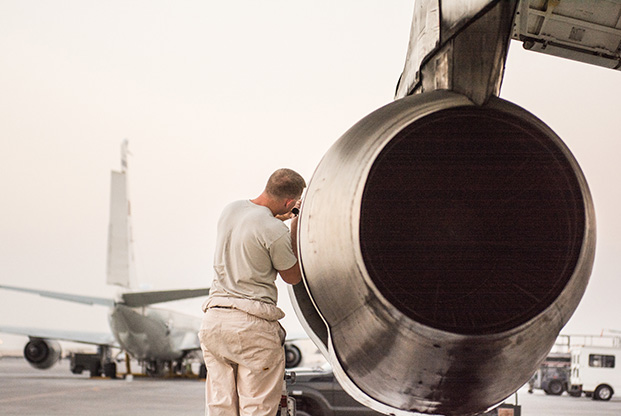
The Combined Air Operations Center at Al Udeid AB, Qatar, provides command and control for airpower throughout the CENTCOM region. Photo: TSgt. Paul Labbe
Al Udeid Air Base, Qatar—
As the US continues to fight the war against ISIS and resumes a more proactive role in Afghanistan, the 379th Air Expeditionary Wing is intimately involved—at every step of the kill chain.
Nicknamed the Grand Slam Wing, the 379th is the largest expeditionary air wing in the world. It comprises intelligence, surveillance, and reconnaissance from RC-135s and E-8s, global strike capabilities from B-52s or B-1s, mobility with the C-17, C-130, and C-21, and refueling from the KC-135. It also runs the Mideast Combined Air Operations Center (CAOC), critical command and control functions, and has space and cyber capabilities.
The wing “provides critical support to the Air Force” across the spectrum of missions in the Middle East and South Asia “with frequent reach into other combatant commands,” said Col. Jeffrey T. Schreiner, vice commander of the 379th AEW.
It “touches every aspect” of the war effort, both kinetic and nonkinetic, “24/7, 365 days a year,” Schreiner added. The kill chain is the process by which USAF will find, fix, track, target, engage, and assess in its wartime operations, before repeating the cycle again, as needed.
Operations, maintenance, and mission support all have to work together to keep the mission flowing, said Col. Tom Bongiovi, commander of the mission support group. There is a similar collaboration with the host nation and with other wings, he said.
One aircraft in the wing hits the first four notches on the kill chain—find, fix, track, and target—all by itself: the E-8 Joint Surveillance Target Attack Radar System, or JSTARS.
Maj. Michael Artifon, director of operations for the 7th Expeditionary Airborne Command and Control Squadron, took Air Force Magazine on a tour of the airplane as it was preparing to launch. He explained its ability to gather real-time intelligence and layer multiple sources of intelligence together.
For example, he said, although ISIS fighters in Iraq are now on the run and hiding, the JSTARS can detect a pattern to determine the location of those fighters. In Afghanistan, the aircraft may be called upon to watch a narcotics facility for a few hours, to ensure no one is inside when it’s bombed. Such attacks deprive the enemy of funding sources.
The JSTARS is also tapped for convoy overwatch, Artifon said.
“Most of what we’re doing on a daily basis is surveillance,” he said, though the shift to Afghanistan at the beginning of the year involved the aircraft with some kinetic strike missions as well.
Lt. Col. Ryan Zeitler, commander of 7th EACCS, said that JSTARS sensors gather real-time ground surveillance and targeting data, and airmen and soldiers aboard the aircraft work to find what’s important and meaningful on screens that sometimes look like someone “threw a bag of Skittles” on them.
The JSTARS is “best in class” for air-to-ground radar and wide-area surveillance, Zeitler said. With about 18 people on board, it’s much larger than any other platform with similar capabilities.
Further down the kill chain, centering on “engage,” are the bombers. For two years they were B-52s from Minot AFB, N.D. A squadron of B-1s replaced the BUFFs in early April.
Lt. Col. Danny Lambert, 69th Expeditionary Bomb Squadron director of operations, explained that his group from Minot was the first operational rotation to use the new conventional rotary launcher upgrade for the B-52. The rotary launcher—not unlike a revolver—allows the bomber to carry up to eight GPS-guided bombs internally on each launcher, increasing its overall capacity from 16 smart bombs to 24, Lambert said.
In just five months, the B-52s had flown about 420 missions and 4,500 hours, Lambert said, executing dynamic, emerging missions and answering requests for fire from ground commanders in Iraq, Syria, and Afghanistan.
“The mission changes every day,” he said, and it’s not always about striking the enemy.
Sometimes, Lambert said, it is about finding actionable intel on the ground with the aircraft’s Sniper or Litening targeting pod. The crew might find and strike something on the same mission, or they might “get the assist,” Lambert said: Finding a target, then passing the information on for someone else to destroy it.
Capt. Grant Ellison, a weapons systems officer with the 69th EBS, said that while the pod is a great tool for seeing what’s happening on the ground and talk to JTACs [joint terminal attack controllers], it can be difficult to find something.
“It’s like looking through a soda straw,” he said.
The biggest advantage the B-52s offer is firepower, Lambert said, and their endurance in the area without refueling.
Early this year, the squadron was the heaviest hitter in Operation Inherent Resolve, Lambert said, expending weapons “pretty much every day.”
Despite the B-52’s age, the roughly 215 maintainers who made up the 69th Expeditionary Aircraft Maintenance Unit helped the squadron and wing set several records during their deployment. These included a streak of 834 sorties without a maintenance cancellation.
The last step in the kill chain—“assess,” is handled by RC-135 Rivet Joints of the 763rd Expeditionary Reconnaissance Squadron, which also starts the cycle again by finding new targets.
Capt. Christopher Costello, mission planning team chief with the 763rd ERS, said the aircraft is the “premier SIGINT [signals intelligence] platform for the Air Force,” and can do onboard processing to provide real-time intelligence to troops and commanders on the ground.
In OIR, that means trying to find ISIS fighters by locating different signals. The Rivet Joints also wrap up the kill chain by assessing intelligence after a bomb is dropped on target, Costello said.
The Active Duty crew of about 23 people fly roughly 10-hour missions during which they use the Rivet Joint’s onboard sensor suite for real-time on-scene intelligence collection, analysis, and dissemination. They also work with numerous groups at the CAOC, getting information from them, and giving intelligence back.

An E-3 Sentry takes on fuel from a KC-135 Stratotanker during a mission over Syria. Photo: TSgt. Joshua Strang
INSIDE THE CAOC
On the operations floor of the Combined Air Operations Center, most of the faces of US troops are lit by giant computer screens—two or three per person. The overhead lights are off, but the glow of the massive TV screens covering the walls casts a bluish glow, illuminating every type of US camouflage and flight suit, along with a handful of coalition partner uniforms.
In this room, yesterday is ancient history.
Up above, the Combined Forces Air Component Commander, deputy CFACC, and troops in the “battle cab” literally oversee it all.
RAF Air Commodore Harvey Smyth, the CAOC director, walked Air Force Magazine through how the CAOC works, likening it to a machine with a lot of cogs; his role is to run the machine.
The cogs include ISR, strategy, mobility, refueling, and combat plans—the troops who build an “excel spreadsheet of awesomeness” to be executed by the ops floor, Smyth said.
Everything must be done quickly, he said, but the CAOC does “phenomenally well” in reacting and adapting as things change.
“We do a lot of nonkinetics here,” such as directed electronic attack, Costello explained. Al Udeid’s CAOC and Rivet Joint aircraft are disparate systems whose troops share at least one common goal: getting information to the customer more quickly.
Rivet Joints have been flying in the region since Aug. 9, 1990, including supporting the war in Afghanistan since the beginning. Lt. Col. Aaron Gray, commander of the 763rd ERS, noted they’re being used in “new and exciting ways” as the fight evolves.
“The reason the 763rd has been in CENTCOM for so long is because of the unparalleled capabilities our aircraft brings in helping fight and win our nation’s wars,” Gray said.

SrA. Chelsie Malloy (left) and TSgt. Dustin Hyden ready a B-52 conventional rotary launcher for transport at Al Udeid. Photo: SSgt. Patrick Evenson
UPS AND DOWNS FROM KEESLER
Outside the kill chain, but playing a critical role in the fight, are the C-130s of 8th Expeditionary Air Mobility Squadron.
The air guardsmen of 815th Airlift Squadron brought their C-130Js from Keesler AFB, Miss. The J models fly higher, with a smaller crew, and can carry two extra pallets. They go “higher, faster, farther,” than other C-130 models, explained Lt. Col. Keith Gibson, commander of the unit.
“We’re kind of the hub and spoke” and can reach nearly anywhere in the CENTCOM area of responsibility—even deep into Afghanistan, because of the fuel efficiency of the J model, Gibson said. “We affect every unit here.”
The aircraft can land on a 3,500-foot dirt strip, or do air-drop if necessary to resupply “troops in contact” with the enemy. Onboard GPS allows precision airdrop from high altitudes, allowing the aircraft to stay out of the range of enemy fire, Gibson added.
The transport is also night-vision capable with the flip of a switch, making it “very combat friendly,” he said.
The airmen stayed busy during their tour in the region, with 75 percent of the aircraft tasked every day. That they deployed at all was unexpected. The unit was slated to close and was only 48 percent manned—with only 10 percent combat qualified—in October 2015, explained CMSgt. Troy Peltier, the squadron superintendent.
Gibson described the unit as being “decimated” at the time, with only a core cadre of airmen remaining.Then the squadron’s status changed, and it started rebuilding. It began requalification training in February 2016 and was declared fully operational in November 2017 for a January deployment.
“It was a roller-coaster,” Peltier said.
The maintenance squadron also had to rise to the challenge, standing up a second maintenance unit on Sept. 11, 2016, and deploying 16 months later. “It’s a success story,” Gibson said. “We’re back in business.”
Brig. Gen. Jason R. Armagost, the 379th AEW commander, said the wing is “the most Total Force-integrated operation I’ve ever seen.” It’s “a picture-perfect example” of integration. “Everybody’s invited to the table.”
It can seem incredibly complex, but it works, Armagost said.

SSgt. Daniel Spear runs through a postflight inspection of the intake and exhaust system on an E-8C JSTARS at Al Udeid. Photo: SSgt. Patrick Evenson
FUELING IT ALL
Also outside of the traditional kill chain, but critical for every step of its operation, are the KC-135s of the 340th Expeditionary Air Refueling Squadron.
Lt. Col. Cory L. Clagett, commander of the 340th EARS, said it isn’t easy refueling the “largest combat flying squadron in the Air Force.” Most wings don’t have as many airplanes, he said, and everyone relies on the tankers.
Active Duty troops deploy on a one-to-one ratio and are supplemented by Guard and Reserve airmen. “That’s how we make the air war happen,” he said.
Zeitler, of the JSTARS squadron, emphasized the crucial role the KC-135s play. “None of this happens without the tankers. No tanker means no persistence,” he said.
Clagett said the airmen pride themselves in knowing that bombers, ISR platforms, and other aircraft never have to worry about running out of fuel. The “world’s top mobile gas station,” as KC-135 pilot 1st Lt. Ali Rizvi called it, is plenty busy.
Al Udeid is the largest defense fuel supply point in the DOD, with 270 million gallons of jet fuel supplied in 2017. Although the fuel farm at Al Dhafra AB in UAE has more storage for fuel, Al Udeid delivers more.
The Al Udeid-based tankers supply OIR and Afghanistan, but the Air Force moved some tankers to Afghanistan at the beginning of the year to make things more efficient. Clagett said the move eliminated about six hours of flying time.
“The synchronization of effort is amazing,” said Lt. Col. Jason Grubaugh, deputy commander of the operations group. “We really do quite a bit here on this base,” he understatedly added.
All the airmen can see the effects they’re having, which boosts morale, and the character of the war has changed,” Grubaugh said.